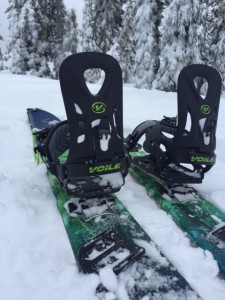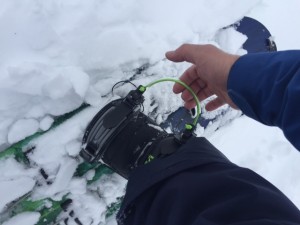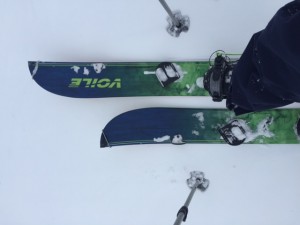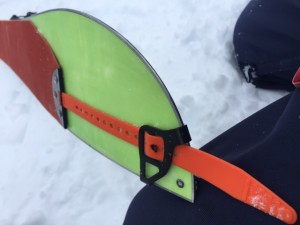The Revelator has made some very favorable impressions right from the start. Light, stiff and very responsive, this board upped the ante with top-notch construction and superior performance. The first thing I noticed while setting up the board was how light it felt (Pawlonia Wood Core). Most split setups can easily be twice the weight of your normal board so right off the bat I knew I might like this.
The next standout was the new Voilé Channel Puck System, which vastly increases your stance options. Using the Alignment Guide (on your initial binding setup), you’re able to slide and angle the pucks (within reason) up and down the channel to fine-tune your stance fairly quickly.
As I was setting up my stance, I noticed something I never expected to see — canted pucks! Back in the day, I used to ride cant plates on my board but everyone I used eventually broke and were impossible to replace. I was excited to see Voilé added this (2½° canted puck) to their system as it does provide a more forgiving feel on your knees. It also gives you a bit of leverage/pressure advantage on your tip and tail.
With the increasing popularity of sidecountry at resorts, a lot of people utilize lift-access to their backcountry stashes. Inevitably, a lot of people are riding their splitboards in-bounds part of the time. As most of you know, riding groomers does not bring out the best on a splitboard. I normally don’t ride my split on hardpack but I wanted to get a good feel for how this board actually responds. Splitboards tend to be heavy, clunky and just plain awkward on firmer snow. The Revelator absolutely rips and rides just as good as my Burton Custom X in the resort. The Revelator wants to carve and is super stable. It blasts through crud, floats powder and rails on hard pack. Even though it is on the stiffer side (which I prefer), I found this board to have some pretty legit snap (long camber area) when I needed it to flex. I would have no problem riding this board in the resort as my main board.
Light Rail Binding
My kit included the Voilé Light Rail Bindings, a sleek and stout, rigid binding. You can feel its quality build with how smooth they slide on and off the pucks. The binding’s base plates are laser cut 6061-T6 aluminum, designed to be lightweight and patterned for minimal ice build-up. Once you set up the bindings on the board, the cut outs in the base plates allow you to adjust your stance on the fly without having to remove the bindings or use the alignment guide (pretty slick).
The straps are both very comfortable and ratchet and release very smoothly. This binding comes with an Avalanche Rip Cord for quickly releasing both straps simultaneously. I was skeptical of these in the past, but I have to say they worked pretty damn well. Anything to keep my transition times down, I am open to.
Touring Performance
Thoroughly impressed with how this board behaves in the resort, I took it out of bounds to switch to touring mode. Pulling the board apart, you can see and feel the improved construction of the Hooks & Clips. The transition was smooth and quick. There’s nothing like quality craftsmanship and precise machining to make you feel confident with your setup.
Switching the bindings to free-heel mode, I noticed the wider touring brackets along with the beefed up pivot bushings on the binding. Of all the moving parts involved in a tour, this is where side-hill stability (arguably your most vulnerable position) comes into play.
The highback has a tour mode too, so your leg can extend further back to length your stride on the flats. I didn’t do any flat sections of any length, so I never really tested this feature, but it’s nice to know it’s there if I’m ever on a tour with some rando friends who don’t think twice about long flat approaches.
Skins
After ripping apart the new Voilé Skins, I was pleased to see they came equipped with adjustable tail clips (integrated with the much admired Voilé straps). They were pre-adjusted to my board’s length. Before I knew it, I was off with a quick glide and moving on up. Once I started climbing I really noticed how a lightweight set up becomes a key factor in conserving energy. I had a pretty easy time breaking trail and tacking up to the top. Sliding the pins and bindings off, unhooking tip and tail, unclipping and ripping the skins went without issue. The board assembly was effortless and a pleasure to feel how everything goes back together so smooth and tight.
Riding the Wild
Since the top of the slope was quite wind affected, the first 40 yards were buffed and almost firm. This board held edge like a knife and floated (early rise, large nose and tapered tail) as the snow turned into a good foot of powdery goodness.
Approaching tree-line, I started to realize I needed to make some pretty tight turns. Since this board was a little longer than I normally ride, I was concerned it was going to be too much board to handle. I was able to make super quick, short radius turns through the trees, no problem. I was definitely able to drive this board instead of it driving me.
I’m very impressed with how it handles across so many types of conditions I encountered. The entire package, the Revelator splitboard with Light Rail bindings, is designed and executed with a lot of thought and precision. I feel confident recommending this setup to my friends and give kudos to Voilé for a job well done.
Voile
Revelator Splitboard
MSRP: $625
Comes with channel puck system, pucks included. Bindings sold separately.
| Length (cm) |
159
|
162
|
165
|
169
|
| Dimensions (mm) |
298-257-286
|
302-261-290
|
305-263-292
|
308-264-294
|
| Sidecut |
8.8 m
|
9 m
|
9.2 m
|
9.4 m
|
| Weight (pounds) |
6 lbs., 6 oz.
|
6 lbs., 8 oz.
|
6 lbs., 11 oz.
|
6 lbs., 14 oz.
|
| Weight (kg) |
2.89 kg
|
2.95 kg
|
3.03 kg
|
3.13 kg
|
© 2016





Recent Comments